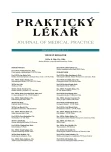A view of young Czech practotioners on vocational training – research questionnaire
Authors:
P. Vychytil 1; K. Sklářová 2; J. Štolfa 3; F. Peters-Klimm 4; D. Marx 1
Authors‘ workplace:
KompetenzZentrum Allgemeinmedizin Baden-Württemberg
; Univerzita Karlova, Praha
3. lékařská fakulta
Kabinet veřejného zdravotnictví
Vedoucí: MUDr. David Marx, PhD.
1; Mladí praktici, o. s., Praha
Předseda: MUDr. Pavel Vychytil
2; Institut postgraduálního vzdělávání ve zdravotnictví, Praha
Katedra všeobecného praktického lékařství
Vedoucí: MUDr. Josef Štolfa
3; Universitätsklinikum Heidelberg
Abteilung Allgemeinmedizin und Versorgungsforschung, Deutschland
4
Published in:
Prakt. Lék. 2011; 91(9): 528-531
Category:
Of different specialties
Overview
European general medical practice has long been challenged by a lack of physicians and a poor quality of their training. In response to this fact the European organisation of young general practitioners (VdGM) carried out a study examining the conditions and motivations of young general practitioners in seven European countries. In this paper we present the results of the Czech portion of the study. The study used web-based questionnaires aimed at the target group of general practitioners in postgraduate training and physicians within five years of passing their qualification exams.
The results show that general practice is an attractive specialty in particular due to the opportunity of individual practice and the possibility of combining professional work with family life, while the most important factor against choosing this specialty was the insufficient remuneration of physicians during their postgraduate training. Our results also show that the existing postgraduate training sub-optimally covers certain areas important for general practitioners (management of GP surgery, holistic approach, work within a community).
The identified positives of the specialty point towards the possibility of targeting the presentation of general practice to attract new medical practitioners. At the same time the negatives should serve as a basis for changes to the postgraduate training curriculum so that it better fulfils the needs of young general practitioners.
Key words:
general practice, vocational training, trainees, quality of education.
Sources
1. Gerylovová, A, Holčík, J. Vývoj střední délky života ve 20. století a jejích rozdílů podle pohlaví. Demografie 2000, 42, 2, s. 85-91.
2. Jones, R., Grol, R. Primary care around the world. In Jones, R. et al. Oxford textbook of primary care. New York: Oxford University Press, 2005.
3. ÚZIS. Lékaři, zubní lékaři a farmaceuti 2007. Praha: ÚZIS, 2009.
4. Vasco da Gama Movement. Vasco da Gama Movement (on line). 2009-10-08 (cit. 2010-06-05). Dostupný na:
5. Vychytil, P., Marx, D. The reform of specialist training for general practice in the Czech republic. Cent. Eur. J. Public. Health 2009, 17(3), p. 146-151.
6. WHO. Process of translation and adaptation of instruments (on line). 2010-12-10 (cit. 2010-12-20). Dostupný na: http://www.who.int/substance_abuse/research_tools/translation/en/.
7. WONCA Europe. The European definition of general practice/family medicine, 2005. (on line). 2010-11-02 (cit. 2010-12-20). Dostupný na: <http://www.woncaeurope.org/Web%20documents/European%20Definition%20of%20family%20medicine/Definition%202nd%20ed% 202005.pdf>.
8. Vasco da Gama Movement – pracovní skupina evropské odborné společnosti VPL – WONCA Europe, která sdružuje mladé praktické lékaře, tzn. lékaře ve specializační přípravě ve VPL a lékaře do 5 pěti let od složení atestační zkoušky ve VPL nebo jejího ekvivalentu v jednotlivých zemích.
Labels
General practitioner for children and adolescents General practitioner for adultsArticle was published in
General Practitioner

2011 Issue 9
Most read in this issue
- Orthostatic hypotension
- Glomus tumour of a finger
- Demodicidosis
- Interaction of alcohol and other drugs: a serious problem
